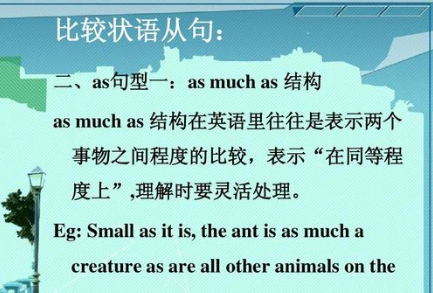本文目录
什么叫状语从句
状语从句:
用一个句子(从句)来作另一个句子(主句)的状语,用作状语的句子就叫作状语从句。作什么样的状语就叫什么类型的状语从句。例如:条件状语从句就是用一个句子来作条件状语。
状语从句的分类:
(1)时间状语从句
凡是从句都必须有引导词,引导时间状语从句的词有when,before,after,until,as soon as,while 等。
(2)条件状语从句
主要看一下由if引导的条件状语从句。if 意为“如果”,引导条件状语从句时,表示假如有从句的动作发生就(不)会有主句的动作发生。例如:
If it doesn't rain tomorrow,we will go there by bike.如果明天不下雨,我们就骑自行车去那里。
If I get there early,I can see the doctor quickly.如果我早早地到那里,我就可以快点看病。
3)地点状语从句用法要点
常用where(哪里)和wherever(无论哪里)eg.
Where there is a will,there is a way. 有志者,事竟成。
We will go wherever the motherland need us most. 我们要到祖国最需要的地方去。
(4)原因状语从句用法要点
常用的引导连词有because,as和since,三者的区别是:在回答问题的时候,使用because;对于显而易见的原因,常用as或since;as和since的从句常放在主句之前,而because的从句常放在主句之后。eg.
Why did you go? I went because Tom told me to go. 你为何去?那是因为汤姆叫我去。
He was angry not because we were late but because we made a noise.
他很生气不是因为我们来迟了,而是因为我们弄出了声音。
As it was raining hard,we had to be indoors. 由于雨太大,我们只好呆在家里。
Since you feel ill,you'd better not go to work. 既然你感觉不舒服,你最好不要去上班了。
(5)目的状语从句用法要点
常用的引导连词有so that,that和in order that译为:以便,为了,目的是。eg.
Please speak more slowly so that we can make full notes. 请讲慢一点,以便我们能作详细笔记。
I shall write down your address that I may not forget. 我要把你的地址记下来,以免忘记。
I sent the letter by air mail in order that it might reach him in time. 这封信我以航空信发出,以便他能及时收到。
注:目的状语从句可以用动词不定式来替换做目的状语。eg.
We work harder than usual finish it in a week. 我们比平常加倍努力工作以在一周内完成工作。
三、主句与从句时态一致的问题。
在时间状语从句和条件状语从句中,主句和从句之间的时态一致问题一般分下列两种情况:
1. 若主句是祈使句,或主句中有情态动词,或主句中谓语动词是一般将来时,那么从句用一般现在时表示一般将来时。例如:
Be careful when you cross the road. 过马路时要小心。
Put up your hand if you have any questions to ask. 如果你们有问题要问的话,请举手。
The traffic must stop when the lights are red. 红灯亮时,车辆必须停下。
2. 若主从句谓语动词都是陈述过去,那么主从句都可以用一般过去时。例如:
She could sing when she was four years old. 她四岁的时候就会唱歌。

原因状语从句和目的状语从句
状语从句即指在主从复合句用作状语的从句。那状语从句具体要怎么使用呢?以下是由我整理关于状语从句的用法的内容,希望大家喜欢!

状语从句的用法
一、概说
按照其意义,状语从句可分为时间状语从句、地点状语从句、原因状语从句、目的状语从句、结果状语从句、条件状语从句、让步状语从句等。状语从句是高中英语学习中的一个语法重点,也是历年高考重点考查的内容之一。学习状语从句主要应注意引导状语从句的从属连词的用法与区别,以及从属连词在一定的语言环境中的意义与用法。
二、时间状语从句
1. 引导时间状语从句的从属连词很多,常见的有before, after, when, while, as, since, till, until, as soon as 等。
2. 表示“当…时候”的 while, when, as 的用法区别是:while从句中的谓语动词必须是延续性动词;表示带有规律性的“每当”或当主、从句谓语动词的动作发生有先后时,只能用 when;当表示“一边…一边…”或“随着”时,只能用 as。另外,用于此义的 as 所引导的时间状语从句谓语只能是动作动词,不能是状态动词。如下面一道高考题的答案是 B 而不能是A:
“I’m going to the post office.” “_____ you’re there, can you get me some stamps?”
A. As B. While C. Because D. If
3. until 在肯定句中通常只连用延续性动词,表示相应动作结束的时间;在否定句中通常连用非延续性动词,表示相应动作开始的时间,意为“直到…才”。如:
He waited until she was about to leave. 他等着一直到她准备离开。
I did not begin to work till he had gone. 他走了后我才开始工作。
4. 表示“一…就”除用 as soon as 外,还可用 the minute, the second, the instant, immediately, directly, instantly, no sooner…than, hardly…when 等。如:
I came immediately you called. 你一来电话我就来了。
Hardly had she arrived when it began to snow. 她刚到就下起雪来了。
The moment I have finished I'll give you a call. 我一干完就给你打电话。
5. every time, each time, (the) next time, (the) last time, by the time, the first time, any time 等以 time 结尾的词语也可用作连词,引导时间状语从句。如:
Next time you come in, please close the door. 下次你进来,请关门。
He didn’t tell me anything the last time I saw him. 上次我见到他时他什么也没告诉我。
By the time I got home, she had already gone to bed. 我到家时她已睡觉了。
三、条件状语从句
1. 引导条件状语从句的从属连词主要有 if, unless, as [so] long as等。如:
Don’t come unless I telephone. 除非我打电话,否则你别来。
If you watch carefully you will see how to do it. 如果你仔细瞧你会看出该怎样做。
As long as you do your best, we’ll be happy. 只要你尽力,我们就满意了。
2. in case 也可引导条件状语从句,其意为“如果”、“万一”。如:
In case I forget, please remind me about it. 如果我忘了,请提醒我。
四、让步状语从句
1. 引导让步状语从句的从属连词主要有 although, though, however (=no matter how), even if(即使), whether…or(不论…还是)等连词。如:
The speech is good, though it could be better. 这次演讲不错,虽然还可以再好一点。
He went out even though it was raining. 尽管下雨,他还是出去了。
2. as 也可引导让步状语从句,但要将名词、形容词或副词等提到 as 前,若提前的是单数可数名词,要省略 a / an。如:
Teacher as he is, he can’t know everything. 虽然是老师,他也不可能什么都懂。
3. 连词 while 有时也可表示“尽管”、“虽然”,引导让步状语从句。如:
While we don’t agree we continue to be friends. 尽管我们意见不同,我们还是朋友。
4. whatever, whoever, however, whenever, wherever 等引导让步状语从句。如:
Don’t lose heart whatever you do. 不管你做什么,都不要灰心。
Whoever you are, you can’t pass this way. 不管你是谁,你都不能从这里通过。
注:表示“虽然”的 though, although 不可与 but 连用,但可与 yet, still 连用。
比较状语从句用法总结
下面是我整理的一些关于状语从句用法的 总结 , 希望能帮助大家更好地认识状语从句,提高英语水平。
一、由when, while, as引导的时间状语从句
1. when引导的时间状语从句中的谓语动词可以是延续性动词,也可以是瞬时动词。when有时表示“就在那时”。如:
When she came in, I was doing some housework. (瞬时动词)
When I lived with the Smiths, we used to discuss international issues together. (延续性的动词)
We were about to leave when he came in. (when表示“就在那时”)
2. while引导的时间状语从句中的谓语动词必须是延续性的,并强调主句和从句谓语动词所表示的动作同时发生(或者相对应)。如:
While my wife was reading the newspaper, I was watching TV.
(was reading是延续性的动词,was reading和was watching同时发生)
3. as 引导的时间状语从句中的谓语动词表示延续性的动作,一般用于主句和从句动作同时
发生,有时也可以强调动作一先一后发生。如:
We always sing as we walk.
As we were playing out, it began to snow.
二、由till或until引导的时间状语从句
till和until一般情况下两者可以互换,但是在强调句型中多用until。需要注意的是:如果主句中的谓语动词是瞬时动词时,必须用否定形式;如果主句中的谓语动词是延续性动词时,用肯定或否定形式都可以,但表达的意思不同。如:
Don’t open it till your birthday.
It was not until the meeting was over that he began to teach me English.
Continue in this direction until you see a sign.
I didn’t work until he came back.
三、由since引导的时间状语从句
1. 若since引导的状语从句的谓语动词是终止性的过去时,则从句表示的时间是“从动作开始的那一时刻起”。如:
He has studied very hard since he came to our school.
We have been missing them since they left here.
2. 若since引导的状语从句的谓语动词是持续性动词或表示状态的动词的过去式时,则从
句表示的时间是“从那持续动作或状态结束时算起”。如:
How long is it since you lived in Shanghai?
John is now with his parents in New York. It is already three years since he was a teacher.
四、由as soon as, immediately等引导的时间状语从句
as soon as, immediately, directly, instantly, the moment, the instant, the minute等这些词语均表示“一……就……”。如:
I want to see her the moment she arrives.
I came immediately I heard the news.
注意:hardly (scarcely, rarely) … when / before; no sooner … than也表示“刚……就……”,但是其主句使用过去完成时,从句用一般过去时,而且,当hardly, scarcely, rarely和no sooner位于句首时,主句应用倒装语序。如:
Hardly had we begun our walk when it began to rain.
I had no sooner left than she called.
五、由each time, every time引导的时间状语从句。如:
Each time she moved her head she let out a moan.
六、由by the time引导的时间状语从句
如果从句的谓语动词用一般过去式,主句的谓语动词用过去完成时;如果主句的谓动词用一般现在式,主句的谓语动词用将来完成式。如:
By the time they get here, we’ll have finished the work.
By the time you come here tomorrow, I will have finished this work.
七、由the first time引导的时间状语从句
the first time常引导时间状语从句,其重点不是讲第一次做什么,而是说明另一动作或情况;也可以作表语,强调到说话为止某一情况或动作的次数。如:
I knew we would be good friends the first time I met her.
比较:for the first time表示有生以来或一段时间内第一次做某事,在句中一般单独作状语。如:
The two girl students talked for the first time at the beginning of the term.

什么是时间状语,地点状语
状语(adverbial,简称adv.)是句子的重要修饰成分,是谓语里的另一个附加成分,从情况、时间、处所、方式、条件、对象、肯定、否定、范围和程度等方面对谓语中心词进行修饰、限制。
在不同的语言中“状语”有不同的作用,中文状语是动词或形容词前面的连带成分,用来修饰、限制动词或形容词,表示动作的状态、方式、时间、处所或程度等;英语状语修饰动词、形容词、副词或整个句子;德语状语修饰动词、形容词、副词或整个句子。
相关用法:
1、副词一般在句子中做状语
He speaks English very well. 他英语说得非常好。
其中的“very”是程度副词,用来修饰“well”。“very well”是修饰“speak”的程度状语。
2、不定式在句子中可以作目的状语
I come specially to see you. 我专门来看你。
3、介词短语
Ten years ago, She began to live in Dalian.
从十年以前开始,她开始住在了大连。
4、从句作状语
When she was 12 years old, she began to live in Dalian.
她12岁的那一年开始居住于大连。

扩展资料
一、时间状语从句
1、when的用法
(1)when既可引导一个持续性动作,也可引导一个短暂性动作,可用于表示主句和从句动作同时发生或从句动作先于主句动作,有时还可表示从句动作后于主句,意为“当。。。时候”。
(2)when在be about to do。。。when。。。,be doing。。。when。。。,had done。。。when。。。,be on one’s way。。。when。。。,be on the point of doing。。。when。。。等结构中,作“那时突然”讲。
(3)when “既然、鉴于;尽管,虽然(位于主句之后);如果”
2、while的用法
(1)表示“当。。。时候”,引导的动作必须是延续性的。
(2)用作并列连词,表示相对关系“然而”。
(3)引导让步状语从句,相当于although,意为“虽然”,位于主句前。
(4)引导条件状语从句,相当于as/so long as,意为“只要”。
3、as 的用法
(1)表示“当。。。时候”,强调同时发生,不指先后。
(2)说明两种正在发展或变化的情况,表示“随着”,表示时间的推移。
(3)表示“一边。。。一边。。。”。
(4)强调两个动作紧接着发生。
(5)表示“虽然,尽管”。
(6)其他含义“正如,正像”,“作为”,“由于,因为”。
4、before的用法
(1)一般意为“在。。。之前”“。。。才”,“。。。就”“还没有。。。”“免得”“不知不觉”“宁可,宁愿”,“否则,要不然”。
(2)It + will be/was + 时间段+before+一般现在时/一般过去时。在肯定句中,意为“多长时间之后才”;在否定句中,意为“用不了多长时间就”。
5、until和till
(1)与肯定句连用,必须是延续性动词。
(2)与否定句连用,必须是非延续性动词,表示“直到。。。才,在。。。之前不。。。”。
注意:not until可用于强调句和倒装句
强调句:It is/was not until…that…倒装句:not until 放句首时,主句要部分倒装。
6、since的用法
(1)since后是非延续性动词,时间起点从该动作发生算起,意为“做某事多久了”;since后是延续性动词,时间起点从该动作结束算起,意为“不做某事已有多长时间”。
(2)It is/has been +时间段+since+一般过去时
7、表示“一......就......”的句型
(1)as soon as, once,immediately,directly,instantly,the moment,the minute等引导的从句都表示从句的动作一发生,主句的动作随即发生,常译作“一。。。就。。。”,这类从句中,经常用一般现在时态代替将来时态。
(2)on doing sth.或“on one’s+名词”作时间状语。
8、有些名词和副词可以起连接词的作用,引导时间状语从句。
注意:时间状语从句中不用将来时态。若要表示将来时间,可用一般现在时态表示。但when引导名词性从句时,从句中要使用将来时。
二、地点状语从句
1、地点状语从句由where,wherever引导。
注意:where与where的区别:Where表特定的地点,而wherever表示非特定的地点
Wherever=to/at any place where
2、地点状语从句与定语从句的区别
Where引导定语从句时,从句前应有一个表示地点的名词作先行词;而状语从句前则无先行词。
三、原因状语从句
引导词:because, since,as, now that, not that…, but that…, seeing that, considering that, in that
注意:for也可以表示原因,属并列连词,但不是说明直接原因,而是对某种情况加以推断,用于表示补充说明理由。
四、目的状语从句
引导词:so, so that, in order that, that, to the end that(以便,为了),in case,for fear that,lest(以免,以防),
目的状语从句中通常有情态动词can,could,may,might,should,would等。
注意:1、in case 还可表示“万一,假如”。
2、目的状语从句可以用so as to, in order to 等不定式代替,但主句和从句的主语必须一致。
五、结果状语从句
引导词:so...that(如此。。。以至于。。。),such...that(如此。。。以至于。。。),so that(结果是),with the result that(所以,结果是)
注意:(1)so...that与such...that的区别
So+形容词such+a/an+形容词+单数名词
So+形容词+a/an+单数名词such+形容词+复数名词
So+副词such+形容词+不可数名词
So many/few+复数名词
So much/little+不可数名词
(2)so that引导的目的状语从句与so that 引导的结果状语从句
目的状语从句一般使用情态动词,结果状语从句一般不使用情态动词;
结果状语从句常常用逗号与主句分开。
(3)so...that与so...as;such...that与such...as
So...that/such...that为结果状语从句;so...as/such...as为定语从句。
六、条件状语从句
引导词:if(如果),unless(除非),if only(只要,但愿),only if(只有),in case(万一),suppose/supposing(that)
(假设),provided/providing(that)(只要,假若),on condition that(要是,在。。。条件下),so/as long as(只要),(let's/let us)say(假设)
七、方式状语从句
引导词:as(像。。。一样,正如。。。),as if/as though(好像,宛如)
注意:1、固定句型A is to B what C is to D.意为“A对B而言正如C对D一样”。
2、as if, as though引导的从句若与事实相反,用虚拟语气;若与事实相符,不用虚拟语气。
八、让步状语从句
引导词:though/although/as(虽然,尽管),even if/though(即使,尽管),whether/no matter whether...or(not)
(不管。。。是否,不管是。。。还是)wh-ever/no matter wh-(无论。。。)
注意:(1)though,although,as的区别
A、Though,although的主句中可以用yet, still, nevertheless,但不可使用but。
B、though引导的从句可以倒装,也可以不倒装;as引导的从句必须倒装;although引导的从句不能倒装。
其结构为:形容词/分词/副词/动词原形/名词(无冠词)+as/though+主语+谓语……
(2)though可用作副词,放在句末,意为“不过,但是”。Although无此用法。
(3)某些短语也引导让步的从句或短语,意为“尽管”,如:in spite of the fact that, despite the fact that, regardless of(the fact that)
九、比较状语从句
引导词:as...as(和。。。一样),not as/so...as(和。。。不一样),than(比),the more...the more...(越。。。越。。。)
十、状语从句中的省略问题
1、在状语从句中如果主语与主句的主语一致,同时从句中又含有系动词be,则通常可省去从句的主语和系动词be,留下其余部分。
2、若状语从句中主语是it, 动词是系动词be, 则通常可省去主语it及系动词be,留下其余部分。
以上就是关于什么情况下用状语从句 ,什么叫状语从句的全部内容,以及什么情况下用状语从句 的相关内容,希望能够帮到您。

